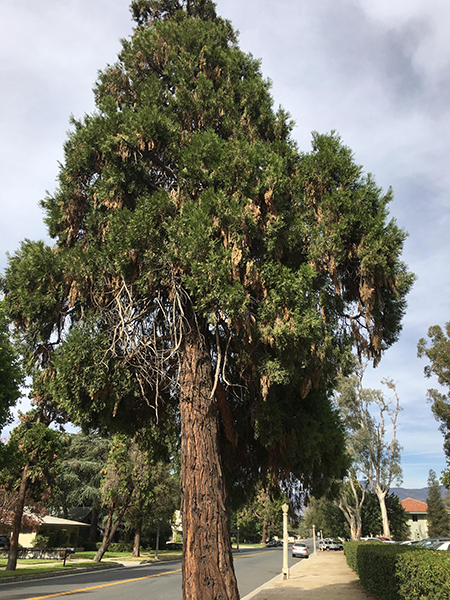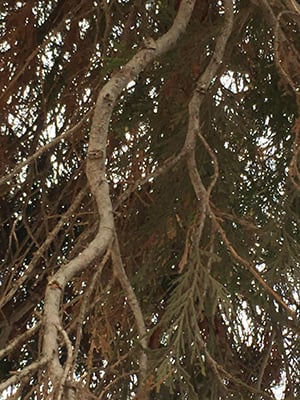University of Redlands Emergency Alert System
Alert Received: . For more information, visit: https://www.redlands.edu/alert/
University of Redlands
- Home
- Trees
- Species Accounts
- Incense Cedar
Classification
Common Name: Incense Cedar
Scientific Name: Calocedrus decurrens
Family: Cupressaceae
Alternative common names: California Incense Cedar, California White Cedar, Bastard Cedar, California Calocedar, Post Cedar, White Cedar, and Red Cedar (Moore, 2002).
Identification:
Habit: Incense Cedar has dark red/brown bark, with dark green leaves that at some times of the year have yellow flowers on them, and grows to approximately 66 – 187 feet tall on average. The trunk’s diameter grows to about 4 feet on average. However, on occasion in the giant sequoia forests they have been seen to grow to 225 feet tall with a 12-foot diameter trunk. The crowns of trees are often irregular in shape and open on top (Tollefson, 2008).

Figure 1: Incense Cedar tree. Photo Credit: Colton Grier
Leaves: The leaves vary anywhere from .12– .55 inches. They scale spread out into 4 smaller whorls of small pieces that make up the leaf (Tollefson, 2008; Moore, 2002).

Figure 2: Incense Cedar leaves Photo Credit: Colton Grier
Twigs & Bark: Incense cedar’s bark is very thick and firm with a dark reddish tint to it. It is around 2 – 3 in. thick on younger trees, but can be as thick as 6 – 8 in. on more established trees (Tollefson, 2008).

Figure 3: Incense Cedar twigs Photo Credit: Colton Grier

Figure 4: Incense Cedar bark. Photo Credit: Colton Grier
Flowers & Fruits: The incense cedar is monoecious meaning different trees produce either male or female cones in order to reproduce. The male cones are .16 – .28 inches long, while the females grow to around 0.6 – 1.5 inches long. The female cones contain around 4 seeds that are .31 – .47 inches long and have wings on each side that vary in size (Tollefson, 2008).
Where it’s from:
Native Range: The incense cedar’s native range stretches down the west coast of the United States from southern Oregon to Baja California. It reaches as far east as western Nevada. It is mainly found in coniferous forests (between 165 – 6,600 foot elevation), and rarely found in other types of forests along the west coast. Incense cedar is extremely tolerant of heat and can live in a very wide variance of temperatures. Its native range has temperatures that stretch from a very low extreme of -30°F all the way to an high extreme of 118°F. Once the plant is established it is able to tolerate these types of temperatures, but in order for the seeds of this plant to germinate it requires temperatures to stay between 32°F to 40°F on bare soil. The ideal amount of sunlight is full sunlight, or a very small amount of shade. Although the incense cedar is able to live in areas that receive only 15 inches of rain, average precipitation along its range stays somewhere between 20 and 80 inches of rain (Tollefson, 2008).

Figure 5: Incence Cedar's Native Range Photo Credit: http://nwconifers.com/nwhi/incense.htm
Ecological Notes: One important aspect to the incense cedar is that it is extremely intolerant to flooding. Incense cedars are tolerant of a wide range of pH levels. It generally grows in soils that are strongly acidic to neutral, but can also thrive in slightly basic soils. The soil type is usually sandy loam and clay loam. The soil should be able to drain well and be very deep. Given in the name of the tree, the aroma given off by the leaves, bark, and wood is a defense mechanism that fends off insects and other possible pests. Incense cedar is prone to getting dry rot, a condition in wood in which a fungus breaks down and makes the wood easily breakable (Tollefson, 2008).
What we use it for:
There are many uses for the incense cedar. This tree in pre-modern medicinal times was eaten for stomachaches and burned & inhaled for colds. The twigs and bark were used to make different tools to be used around camps such as baskets or brooms. Today it is often used for windbreaks in areas with extremely harsh winters. People plant these trees in lines to slightly change direction or alter the power of winds to keep peoples houses warmer. When the wood is not taken over by dry rot, it is actually a very durable wood that does not allow decay, so it is often used for building different parts of houses, park benches, and pencils (Moore, 2002).
Bibliography
Biographer: Colton Grier ’19, BIOL 238: Ecology, Evolution, and Behavior Fall 2017